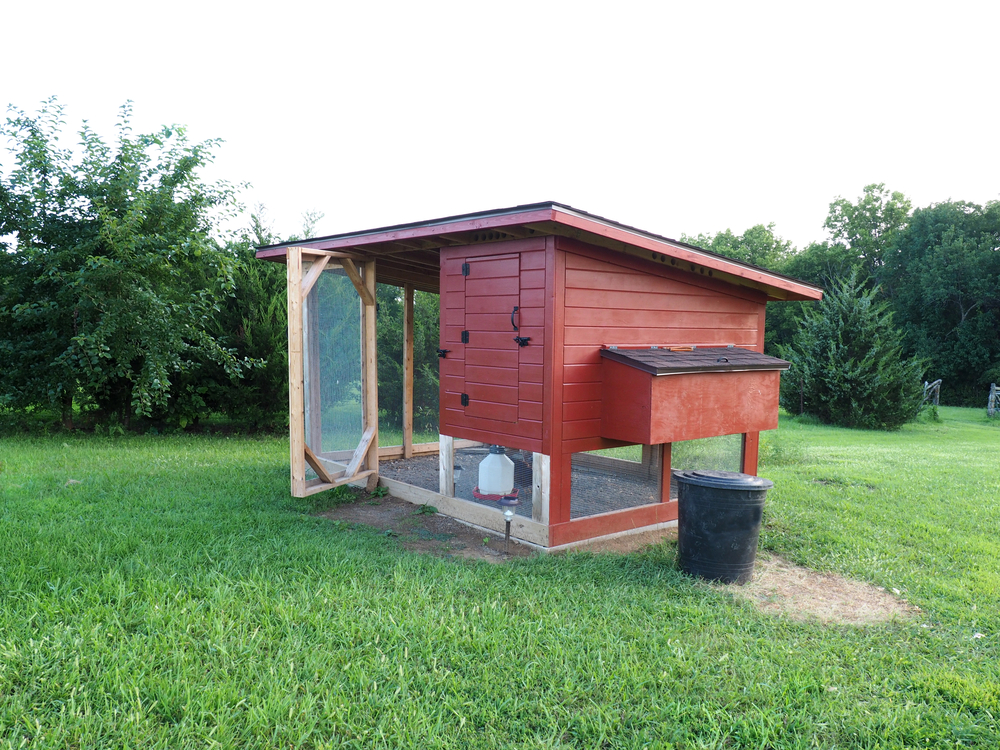
Building your own chicken coops, complete with nesting boxes and chicken runs, lets you care for birds easily in diverse settings. Whether you want to gain more self-sufficiency or simply desire fresh eggs on demand, a backyard henhouse offers the added benefit of fostering healthier eating habits, and if you have a garden, the nitrogen-rich chicken poop you remove from your coop proves a great fertilizer for plants. One of the easiest farm animals in terms of care and maintenance, chickens only require approximately 20 minutes of your time a day — if you set everything up properly before you allow your birds to roost.
Fortunately, the best paint products from the Real Milk Paint Co. make this process much easier with options for both painting and water sealing a chicken coop that keep your birds safe and preserve your hard work.
Reasons for Painting a Chicken Coop
Most timber used for building DIY chicken coops typically has heat treatment for durability and has a smooth surface so your birds don’t get splinters. However, covering the raw wood or even an old paint with a coat of Real Milk Paint or coating it thoroughly with finishing oils adds an extra level of protection from inclement weather and endurance over time. Painting a chicken coop and the nesting boxes inside as well as water sealing it, also makes poop easier to hose off and clean, providing your birds with a more pleasant living space.
Additionally, painting your own chicken coop lets you match it to other exterior home decor for a streamlined appearance, whether you keep backyard chickens in a rural, suburban or urban area.
The vast selection of colors available from Real Milk Paint ensures you’ll find shades that suit the look you want, which is just one reason products from the Real Milk Paint Co. make an excellent choice as coop paint when you’re ready to complete the look of your henhouse in a way that complements your chosen coop design.
Benefits of Real Milk Paint Products
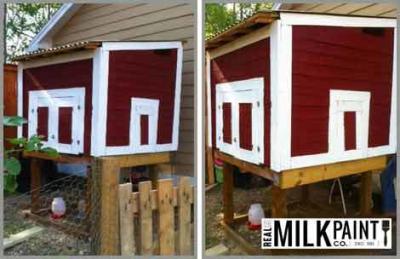
One of the main benefits of using Real Milk Paint products for painting or water sealing a chicken coop is our nontoxic formulations that contain no volatile organic compounds (VOCs). Paint fumes from VOC products can harm chickens’ respiratory systems, so our Real Milk Paint colors and finishing oils offer a convenient way to spruce up your chicken coop and preserve the wood while keeping your chickens happy and healthy. All-natural and organic ingredients in most of our products provide the added benefit of environmental friendliness for sustainable care and maintenance of your particular chicken coop design.
Another advantage of using Real Milk Paint as an interior and exterior paint for your henhouse is that it doesn’t require surface sanding or priming before application. Additionally, our powdered formulation lets you mix as little or as much as you need for your DIY project. You can also make custom formulations for your chicken coop that are thinner or thicker than normal for specific decorative techniques.
Once mixed, the chicken coop paint you create lasts for up to two weeks, ensuring you have ample time to finish painting the outside and inside of the coop. Likewise, our finishing oils come in sturdy containers for fuss-free storage between uses without yellowing or rancidness.
Painting Chicken Coop Interior
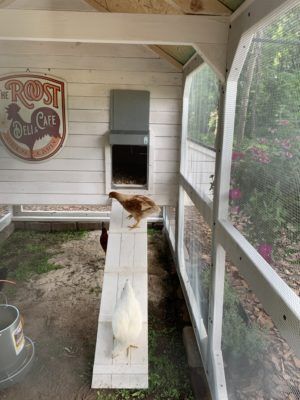
Painting the inside of a chicken coop with Real Milk Paint conveys numerous advantages. By painting the interior wood surfaces of a coop before adding chickens, you are helping to protect it from pesky chicken parasites. Because of the lime content in the milk paint, it helps repel parasites and absorb carbon dioxide through a process known as the “lime cycle”.
Since enclosed outdoor spaces may retain heat in the summer, lighter interior chicken coop paint helps cool things down and keep your birds comfortable as they roost and lay fresh eggs, and since chickens tend to peck at the color red, paints in that hue aren’t a good choice for your henhouse.
Keep in mind also that matte finishes hold up better than gloss or semi-gloss options due to the constant scratching that interior chicken coop painted surfaces endure. Should your chickens ingest any of the non-toxic milk paint, you can rest at ease that it won’t be harmful to your feathered friends.
Before you begin painting the chicken coop, be sure to gather the supplies you need and wipe down the surfaces you’re painting with a quality cleaner that doesn’t leave residue behind such as Tri-Sodium Phosphate.
Next, mix your Real Milk Paint at a 1:1 ratio with water, allowing the foam to subside before you start, and if you want improved protection against mold and mildew, consider adding our Outdoor Additive to the mix.
When you’re ready to paint your chicken coop, use a small brush to work the paint into all cracks and crevices plus areas where wood pieces join together, then coat larger surfaces afterward for full coverage. Let the first coat dry, typically between 30-60 minutes, then add a second coat. Once the second coat inside the coop dries, you’re ready to add shavings and diatomaceous earth and let your chickens in to roost.
Painting a Chicken Coop’s Exterior
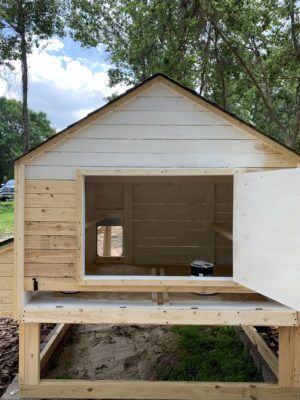
Painting the outside of your chicken coop offers opportunities to get creative with color and accentuate the look of exterior features within your landscaping or your home itself. When you want a classic farmhouse look for your barn paint, consider Real Milk Paint hues such as Barn Red and Soft White for eye-catching contrast, or lend your chicken brooder a more modern aesthetic with deep hues like Lily Pad or Peacock paired with lighter shades such as Cheesecake or Dijon. Blend the chicken coop into the background by using Earth Green or Treebark. Our extensive range of colors offered by The Real Milk Paint Co. ensures you’ll find the perfect color palette for your chicken coop.
Real Milk Paint works just as well on henhouse exteriors as inside the coop. But since the outside is at the mercy of the extremely hot sun’s harsh rays and inclement weather, you need to mix it with our Outdoor Additive to achieve the level of preservation required.
Just like when you painted the inside of the chicken coop, mix Real Milk Paint powder at a 1:1 ratio with water and let the foam die down before beginning. To speed up the process, try our Anti-Foaming Agent, which lets you start painting right after mixing. Two coats — apply one, let it dry and then apply another — should be plenty of coverage for your henhouse and chicken run. Keep in mind, that if milk paint is left unsealed on the exterior, it will slowly wear away from the surface, just like the quaint old barns seen across the countryside. What’s the best way to seal Real Milk Paint for exterior paints? Keep reading!
Water Sealing a Chicken Coop
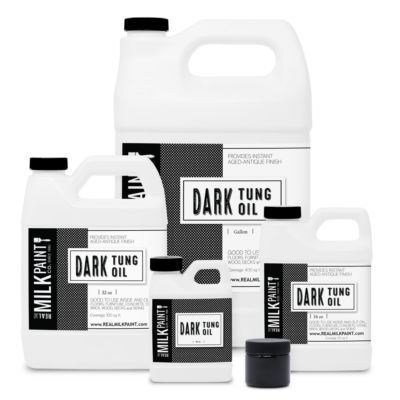
Apply finishing oil over the Real Milk Paint if you want some added protection for your chicken coop paint job and to achieve high-quality results that easily withstand the rigors of time, sunlight, and bad weather. Keep in mind that top coating milk paint with oil tends to darken and make the color more saturated. Or, if you want your henhouse to have a more natural look, opt for water-sealing a chicken coop with only a finishing oil instead of painting it.
Though most timber has some sort of preservative treatment, natural finishing oils such as our Outdoor Defense Oil kick protection levels of your chicken coops up a notch. A combination of Pure Tung Oil, pine oil, and zinc, this finishing oil doesn’t require dilution with a solvent, so you can apply it straight from the container. You can, however, mix it with other oils such as our Dark Tung Oil finish if you want a different cosmetic effect.
Just like our Real Milk Paint, our Outdoor Defense Oil is made with only naturally occurring ingredients, making it pleasant to work with and ensuring it doesn’t hamper your chickens’ breathing over time like other sealants with harmful chemicals. Application is simple — just take a clean, foam or bristle brush and put one coat of the oil into the surface of your chicken coop’s interior and exterior. Give the coat a chance to soak in, then apply another coat over it. Repeat these steps three to five times until the oil no longer soaks into the wood, then wipe away the excess.
Using natural products by The Real Milk Paint Co. in place of harsh paints and varnishes with volatile organic compounds helps you raise chickens that are both healthy and happy. Both our Real Milk Paint colors and our finishing oils provide a greener alternative that helps you feel good about having your own chicken coop while reducing the amount of time and money you have to spend on its setup and continuing upkeep.
Check out this chicken coop that Anne Of All Trades built and finished using many of the techniques mentioned above!
GET STARTED TODAY
Chicken coop paint ideas are many. If you’re not sure where to start or how much paint is needed for an average size hen house, contact us. We’ll give you some tips on using Real Milk Paint and the best paint colors for your chicken coops to color match.
Real Milk Paint Co™ specializes in organic, non-toxic paints, offering a range of environmentally friendly products including oils, waxes, and finishes. Our 100% organic paint is safe for kids, pets and small animals, providing a versatile, easy-to-use solution for various surfaces with a focus on sustainability and health. We have the best paints for your chicken coop and every painting project you want to undertake.



